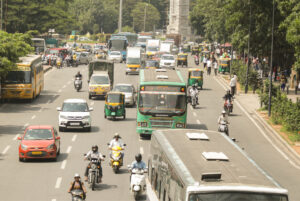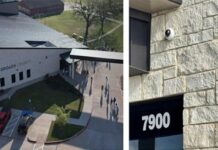
The capital city and the largest city of Karnataka, Bengaluru, is a city of stark contrasts. It’s a city that effortlessly marries the old and the new, the traditional and the modern. Being India’s IT hub and a thriving metropolis, Bengaluru has inevitably attracted people from all over the country.
The increase in population has subsequently led to problems like traffic congestion, violations of traffic regulations, and accidents. Local authorities were dependent on measures like generating violation tickets manually, human interventions in managing traffic conditions, and an automated red light violation system at a few intersections.
The Bengaluru Traffic Authority also observed that violations like riding without a helmet, triple riding on two-wheelers, over-speeding, etc., need to be mitigated with a silver-bullet solution that holistically makes Bengaluru roads safer for citizens. They were looking for a hypermodern solution that automates traffic management & enforcement while monitoring traffic conditions at all times and providing statistical data for analysis.
The Bengaluru Traffic Authority wanted an advanced AI-based solution that is both scalable and delivers accurate results. The increased traffic problems and violations have also led to an increase in the number of accidents. This situation demanded a solution that captured multiple violations in real-time, enhanced situational awareness, inculcated discipline among citizens, and most importantly, made Bengaluru roads safer.
After identifying the problem and formulating a proposed solution, the next and most crucial part of the process was finding the ideal technology partner for this project. After rigorous evaluation and intensive discussions, the Bengaluru Traffic Authority, the stakeholders, and a panel of traffic authorities selected Videonetics as the perfect technology partner in collaboration with MATRIX Security and Surveillance Pvt. Ltd. as the system integrator.
Acclaimed as a market pioneer, Videonetics has secured 150+ cities and monitored 25K+ traffic lanes across many geographic regions. The administration was keen to have an open platform that would help them add more capabilities and applications over time.
With these goals in mind, the AI-powered Videonetics Traffic Management System (TMS) and various use cases such as Automatic Number Plate Recognition, Red Light Violation Detection, Speed Violation, No Helmet Detection, and a few more, deployed at 50 significant intersections.
The automatic number plate recognition solution helped the local authorities identify all suspicious, wanted, and stolen vehicles by accurately capturing and recognising the number plates of cars, taxis, buses, trucks, and autorickshaws (tuk-tuk). This enabled the operators to identify and stop all such vehicles as soon as they were captured by ANPR.
The red light violation detection is an end-to-end solution that revolutionised road monitoring by generating round-the-clock alerts in various forms whenever a vehicle violates a red light at a traffic intersection.
Over-speeding detection feature identifies vehicles that do not adhere to the permissible speed limits on roads and highways, while the built-in ANPR engine captures license plate information to record the violations.
As the city roads are narrow, vehicles plying at high speed can often become the cause of an accident. Many road accidents involving two-wheelers result in head injuries when the riders do not wear helmets. The no helmet detection use case assists traffic police personnel in detecting, identifying, and penalising offenders.
Triple riding detection has also been deployed to ensure the safety of citizens riding two-wheelers. The application captures violations if more than two riders are spotted riding on a two-wheeler.
To force drivers of 4-wheelers to wear seat belts for their own safety, the Bengaluru traffic authority deployed the no seatbelt detection use case solution to analyse live video streams and quickly detect drivers (& co-driver) who are not wearing seat belts while driving.
Another major cause of accidents due to distracted drivers is the usage of cell phones. Videonetics Traffic Management System also provided the use case of detecting a Driver Using a cell phone in real-time by analysing his (or her) gestures and body movement.
All the AI-powered traffic applications described above have helped the city’s law enforcement monitor traffic round-the-clock, record traffic violations in real time, and send alerts to authorities for further action.
Phase – 1 of the project has been completed and covers 50 of the busiest intersections, entry-exit avenues, and areas known to witness regular congestion & accidents.
Smarter traffic management and faster decision-making with Videonetics TMS Dashboard:
Bengaluru traffic officials don’t just receive data on traffic violations in real time but also obtain significant insights on citywide traffic characteristics such as density, headway, and traffic composition at regular intervals, thanks to the Videonetics TMS dashboard.
The dashboard assists traffic officials in making informed decisions, as it keeps them updated on the distribution of vehicles, violations, and incidents across the city. Moreover, they also have access to statistical analysis of the traffic flow at various intersections across the city, filtered by attributes of vehicles such as class, colour, & registration types, and even compare it to the data in the past.
“We are elated to be working with Videonetics on this project. Their AI-based video management solution is revolutionary for government entities, especially in terms of road monitoring. They offer holistic and scalable solutions that empower local authorities to maximise the use of their visual data. Additionally, these solutions ensure enhanced security and governance, promote law-abiding behaviour among citizens, and contribute to making the roads safer.” Aditya G, Vice President – Technical, MATRIX Security and Surveillance Pvt Ltd.
The collaboration between Videonetics, MATRIX Security and Surveillance Pvt. Ltd., and Bengaluru Traffic Authority has been exemplary. Success of this project could be measured by a noticeable impact in various aspects related to road traffic safety and reductions in the number and frequency of violations.
● There have been significant reductions in red light/stop line violations.
● The number of traffic accidents and violations, such as no helmet, triple riding, driving without a seatbelt, and using phones while driving has also plummeted.
● 24×7 active monitoring of traffic and reduction in overall traffic congestion in the city, has helped law enforcement to manage traffic efficiently.
● The city traffic authority receives thorough insights about each intersection from the dashboard, which has facilitated traffic management, especially in peak hours.
● The dashboard has empowered officials to overcome their immediate and long-term traffic management challenges. Now, they are equipped to visualise the trends and patterns related to traffic violations, incidents, and vehicle flows.
● It also combines historical and real-time traffic data to help traffic officials understand key traffic trends, helping them to make better decisions.
● The increased awareness about the traffic rules amongst the citizens of Bengaluru has made them more law-abiding and the roads of Bengaluru are now more organised and safer than ever before.
● The Videonetics Traffic Management System has also hugely aided the local police in solving cases of stolen or hot-listed vehicles, as they can now trace vehicles in real-time using ANPR technology.
● With Videonetics TMS, operators keep a 24×7 watchful eye on the traffic situation, gaining insights about traffic data and responding to threats and accidents proactively, from the Bengaluru Management Center.
● The holistic success of the project stands as a model for other city departments to improve their traffic awareness and make their roads safer.
● The open and modular architecture of the Videonetics TMS empowers city authorities to continue adding more applications for robust traffic management, making it future-ready for expansion.











